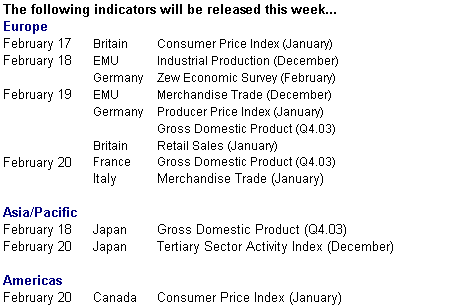Monday, February 16, 2004

Last Week's Highlights
U.S. dollar is where the action is
A variety of events, including a string of disappointing economic data, pushed the dollar down again last week against the euro and toward a record low on Friday. The U.S. merchandise trade deficit expanded more than expected and consumer confidence sank, only adding to the negative market reaction earlier in the week to Federal Reserve Chairman Alan Greenspan's testimony before the U.S. Congress. Traders drove the dollar down after Greenspan said the Fed's 1 percent Fed funds rate - a four-decade low - is appropriate. He also said the dollar's drop isn't hurting the U.S. economy. This compounded market disappointment over the Group of Seven finance ministers' communiqu� the prior weekend, which didn't place a floor under the dollar's decline and failed to reassure the foreign exchange market.

The dollar rebounded to $1.2734 in New York trading after plummeting to $1.2895 earlier in the day on Friday. The dollar sank when the U.S. trade deficit was reported to be $42.5 billion in December. Dollar losses had no place to go and deepened after the University of Michigan confidence index dropped to 93.1 from its prior reading of 103. But then the U.S. dollar rebounded against the euro, erasing most of its losses for the week on speculation (unsubstantiated) that the European Central Bank would sell euros for the first time to stop a two-year rally from hurting European export demand. From a high of $1.2895 the euro sank within two hours to as low as $1.2715. The ECB declined to comment about any currency sales, which usually means that there was no intervention. The ECB bought euros in September 2000, along with other Group of Seven central banks, after the euro sank to about $0.85. The ECB purchased euros on its own in November 2000. It has never sold euros to affect currency rates. The U.S. dollar has declined for 12 out of the past 14 weeks against the euro.
An OPEC surprise!
OPEC ministers, moving to keep oil prices at recent lofty levels, said they would cut output beginning on April 1st and move immediately to rein in the group's recent over-production beyond its official quota. Producing over quota has been an endemic issue for OPEC. Needless to say, this aggressive attack against the prospect of falling demand as the weather moderates in the Northern Hemisphere sent oil prices higher. While traders had expected some move against over-production, the quota reduction caught them by surprise. Demand in the second quarter normally drops due to less energy usage as the weather warms. But the cartel hedged and said it reserved the right to change its mind when it meets in Vienna on March 31st. The organization has faced calls from the U.S. and other importing countries to keep the oil taps open wide.

If members follow through on the twin measures, OPEC effectively will remove some 2.5 million barrels from world markets, or about 9 percent of the cartel's current estimated output. That figure assumes the group currently is over-producing about 1.5 million barrels a day, as conservative estimates from outside analysts and some member countries suggest.
OPEC's reference oil price, which is a few dollars below the price of New York oil futures, has hovered above $28 since December 1st - the upper end of OPEC's price band. The OPEC reference basket price (introduced on January 1, 1987) is the arithmetic average of seven selected crudes including Saharan Blend (Algeria); Minas (Indonesia); Bonny Light (Nigeria); Arab Light (Saudi-Arabia); Dubai (United Arab Emirates), Tia Juana Light (Venezuela), and Isthmus (Mexico). Mexico is not an OPEC member. The OPEC price was $28.96 on Friday.
The International Energy Agency expects demand for OPEC oil to drop about 10 percent in the second quarter to 23.3 million barrels a day - nearly five million barrels a day below the estimated current output. Oil demand growth is surging in some developing economies led in part by strong economic growth in China and Asia - but appears to be temporarily slowing in the OECD, due to the reversal of one-off factors that boosted growth last winter.
OPEC's members have pointed out that a weak dollar means the price of oil is not as high as it appears for non-dollar importers and for many of the producers. This is true for countries where the appreciation of the euro and sterling have more than compensated for the rise in the price of oil. But it doesn't apply to the U.S. or China, whose currency is pegged to the dollar. The U.S. economy is growing strongly and China is importing commodities to fuel its torrid expansion. U.S. and Chinese demand are part of the reason why oil has remained so high for so long despite the end of the war in Iraq. Many thought the combination of Iraq's newly liberated, productive oilfields and a ramping-up of production by Russia - the world's second-biggest oil exporter after Saudi Arabia - would be enough to bring oil prices down.
Global Stock Markets
All equity indexes followed here were up last week with the exception of the Nasdaq. The more impressive gains were in Asia while European equities managed to keep their heads above water. It should be noted that the Mexican Bolsa has soared by 13.5 percent so far in 2004, outpacing all indexes tracked below.
Global Stock Market Recap

Europe and Britain
European stocks rose this week, led by companies whose earnings are most dependent on economic growth. Optimism flourished on hopes that demand will increase because interest rates will remain low. Companies whose earnings are linked to economic expansion have led stock markets gains since a rally began in March 2003. And on Wednesday, the Fed raised its 2004 growth forecast for Europe's largest export market. Fed Chairman Alan Greenspan along with European Central Bank officials have indicated borrowing costs may not need to be increased soon. But gains were trimmed on Friday as companies dependent on U.S. sales, including Royal Philips Electronics NV, Bayer AG and Thomson SA, fell as the dollar slid against the euro. Disappointing fourth quarter flash GDP reports also dampened growth optimism in the EMU. (See indicator scoreboard below.)

In London, stocks closed higher although gains were diminished by disappointing U.S. economic data. Telecommunications were the focus, with investors awaiting clarification as to whether British Vodafone will bid for AT&T Wireless. Vodafone shares were up, but analysts were skeptical as to whether a deal would be in shareholders' best interests.
Asia/Pacific
Asian stocks were up on the week, led by banks which in Singapore, Hong Kong and Australia reported surging earnings. Commodities stocks advanced as a growth forecast from Alan Greenspan and economic reports from China also boosted optimism. Investors are betting on economic recoveries in Asian markets, so they are focusing on the higher earnings momentum of bank stocks.

Oil and basic-material stocks were among last year's best performing equities, bolstered by surging demand from the U.S. and China. Greenspan told Congress on Wednesday that the U.S. economy may expand as much as 5 percent this year, the fastest pace since 1984. In China, a government report showed industrial production grew in January at a record 19 percent.

Indicator scoreboard
EMU - Fourth quarter flash seasonally adjusted gross domestic product was up 0.3 percent and was 0.6 percent above the same quarter a year ago. The flash release contains no data about GDP components. Flash GDP data are calculated by using available information from Germany, France, Italy, the Netherlands and Finland, as well as related indicators from Spain for which GDP data are not yet available.

Germany - Fourth quarter flash real seasonally adjusted gross domestic product inched up 0.2 percent and was virtually even when compared with the same quarter a year ago. The flash report does not provide data for GDP components. However, officials said that an increase in domestic demand was partly offset by weaker net exports.

December seasonally adjusted merchandise trade surplus jumped to �12.42 billion from November's surplus of �9.74 billion. Exports were up 1.6 percent and 3.9 percent when compared with last year. Imports sank 3.9 percent but were up 0.9 percent on the year.

France - Fourth quarter flash gross domestic product was up 0.5 percent and 0.6 percent when compared with last year. As in Germany, data for the components will be available in the next release in about two weeks.

December seasonally adjusted industrial output was up 0.3 percent and up 2.0 percent when compared with last year. Manufacturing input was up 0.2 percent and 2.0 percent on the year. Increases in capital goods and consumer goods barely outweighed declines in semi-finished goods and autos. Construction activity was flat on the month but up 1.4 percent on the year.

December seasonally adjusted merchandise trade surplus jumped to �1.382 billion, up from �322 million in the previous month. Exports rebounded by 4 percent after declining 1.1 percent in November. Strong sales in the aeronautics sector were bolstered by the delivery of the Queen Mary II ocean liner. Sales to other EU countries recovered sharply, flanking rising demand outside Europe. Imports were down 1.3 percent despite rising imports of most consumer goods.
Italy - December seasonally and workday adjusted industrial production dropped 0.2 percent and was down 0.2 percent when compared with last year. Consumer goods output sank 1.3 percent, investment goods output inched down 0.2 percent while intermediate goods dropped 1.1 percent and energy goods fell 0.6 percent. Excluding construction (the number Eurostat uses to compile EMU industrial production), output was down 0.2 percent but managed to edge up 0.1 percent on the year.

Fourth quarter real seasonally adjusted gross domestic product was flat but managed to edge up 0.1 percent when compared with the same quarter last year. As in the EMU, France and Germany, no data were available for components

Britain - January seasonally adjusted producer output prices were up 0.1 percent and 1.6 percent when compared with last year. Input prices sank 1 percent and were unchanged on the year. Price declines appeared to be due to the stronger pound sterling against the dollar.

January industrial production was down 0.1 percent and dropped 0.8 percent when compared with last year. Manufacturing output was down 0.1 percent but up 0.5 percent on the year. Eight of 13 sectors were down. Electrical and optical equipment industries and chemical industries sank on the month. Partly offsetting these declines were increases for food, drink and tobacco industries.

December claimant count unemployment was down by 13,400. The unemployment rate dropped to 2.9 percent from 3 percent in November. For the three months ending in December, the International Labour Organization unemployment measure was down by 21,000 when compared with the previous three months ending in November. The ILO unemployment rate remained at 4.9 percent. This is the lowest rate since the data series began in 1984. Employment was up by 5,000 in the three months to December when compared with the three months ending in November.
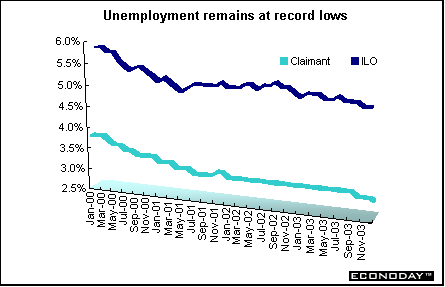
Average earnings for the three months to December were up 3.4 percent when compared with the same three months last year. Earnings growth in the public sector slipped to 4.4 percent. Earnings growth in both the private and manufacturing sectors remained unchanged from the previous three months, at 3.2 percent and 3.4 percent, respectively. Earnings growth in the services sector was down 0.1 percentage point at 3.4 percent.

Asia
Japan - December industrial output was revised to a decline of 0.8 percent, from the initially reported 1.0 percent drop. When compared with last year, output was up 4 percent.
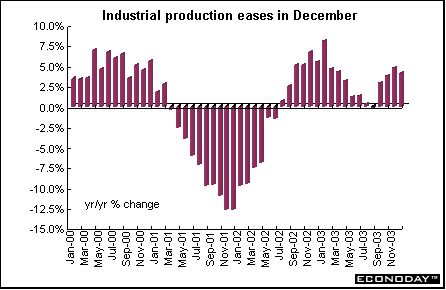
Australia - January employment was up by 13,900 jobs marking the first time in 3� years employment has gained for six straight months. Full time jobs were up by 29,900 but part time jobs fell by 16,000. The unemployment rate rose to 5.7 percent from a 14-year-low of 5.6 percent in December as more people looked for work. There are a total of 9.68 million people employed in Australia, Asia's fifth-largest economy, which has a population of about 20 million. The participation rate, a measure of those with jobs or seeking work, was unchanged at 63.8 percent in January.

Americas
Canada - December merchandise trade surplus widened to C$5.42 billion ($4.1 billion) from C$4.45 billion in November. Exports climbed 3.6 percent as automakers restarted idled production lines. Imports rose 0.7 percent led by natural gas and machinery and equipment. Canada's trade surplus with the U.S., its largest trading partner, widened to C$7.55 billion from C$7.1 billion.
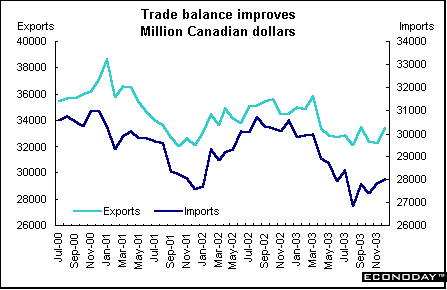
December factory shipments rose 1 percent but were down 0.7 percent when compared with December 2002. By industry, 15 of the 21 major groups, accounting for 64 percent of total shipments, reported increases. Manufacturers of big ticket, durable goods including aircrafts, motor vehicles and parts, rose 1.2 percent, the first increase since September. Nondurable goods manufacturing edged up 0.7 percent. Leading all industries, motor vehicle shipments increased 3.0 percent, recovering somewhat from consecutive declines in October and November. New orders were up 1.6 percent and 1.7 percent on the year. However unfilled orders dropped 0.8 percent thanks to contract cancellations and weaknesses in some industries. Orders are currently at the lowest level since August 1997 and have declined in 15 of the last 16 months.
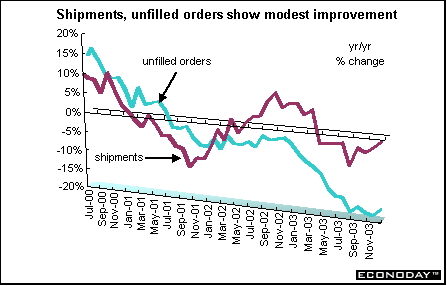
Bottom line
Overseas investors will continue to do as they usually do - keep an eagle eye on what is happening in the U.S. economy and markets. Now especially that earnings season is just about over, merger activities will also attract attention as Comcast's unfriendly bid for Disney moves forward. Also of interest will be the outcome of bidding for AT&T Wireless. New U.S. economic data will be scrutinized given a paucity of new European and Japanese data.
Looking Ahead: February 16 through February 20, 2004
